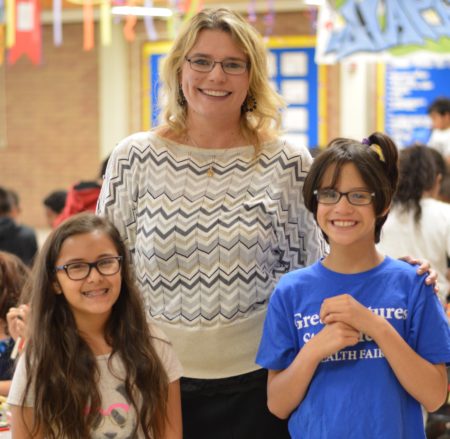As the new CEO of the Boys & Girls Club of the Austin area, Misti Potter has big ambitions for the 50-year-old organization.
By Sarah Holcomb, Photo by Richard Parker

It’s not unusual to spot a crayon drawing hanging in a proud parent’s office. But when Misti Potter explains some of her kids colored the butcher-paper banner behind her desk, don’t be fooled: She’s not referring to her two sons, but her 12,000 kids at Boys & Girls Clubs of the Austin Area.
Since becoming CEO of the organization in March, Potter now oversees BGCAA’s 28 clubs and four outreach organizations, which provide after-school programming focused on academics, leadership and healthy living to youth ages 6 to 18. The clubs are concentrated in low-income areas, where many kids don’t have access to much food, Wi-Fi or transportation at home.
Raised in the oil fields of Stanton, Texas, Potter faced many hardships of her own growing up. When she was 12, she lost her mother to cancer.
“We lost essentially everything,” she remembers. With more than $1 million in medical bills, the family sold their house and cars. “We went from having these really big Christmases to having absolutely nothing under the tree.”
 Potter forged her own way through college. Though she disliked the sport of basketball, she harnessed her athletic talent to earn a full-ride scholarship to a college in Alabama, where she soon discovered her knack for raising money. When a student ambassador challenged her to raise $100 for a fundraiser one afternoon during her freshman year, Potter placed $150 in his palm 15 minutes later.
Potter forged her own way through college. Though she disliked the sport of basketball, she harnessed her athletic talent to earn a full-ride scholarship to a college in Alabama, where she soon discovered her knack for raising money. When a student ambassador challenged her to raise $100 for a fundraiser one afternoon during her freshman year, Potter placed $150 in his palm 15 minutes later.
“It wasn’t even hard!” she says.
She soon landed a job in the college’s grant department. And after Potter received her degree in behavioral science, she went to work in the nonprofit world. Starting off as an administrative assistant in a tiny Boys & Girls Clubs office in North Alabama, Potter set two ambitious goals: to become the president of BGC’s national professional association and to run a multimillion-dollar organization. Before she turned 40, she had achieved both goals, serving as the association’s third female president in 75 years.
“I truly believed that I needed to earn my way up and I needed to understand every level of the organization to do it well from the top,” Potter says. “I was an administrative assistant. I ran programs. I ran clubs. I ran resource development. I’ve done finance. So, I’ve done every piece of an organization and really stair-stepped all the way up.”
Throughout Potter’s 20-year career with Boys & Girls Clubs, she’s helped organizations in Montgomery, Ala.; Memphis, Tenn.; Dallas and Rockwall, Texas, open new clubs and expand budgets, sometimes by millions. In Rockwall, she rescued the club from a state of insolvency within 90 days, growing it from 70 to 800 kids during the course of four years.
For Potter, the best part about waking up every day—a ritual that begins with coffee at 4:30 a.m.—is that she gets to help kids.
“The business side is what I’m really good at, but the reason I do it is for the kids,” Potter says. “If I can’t keep that relationship and that touchpoint, I don’t think the business side would matter.”
She engages with kids in the occasional basketball game or during “power hour,” a homework period at the beginning of each afternoon. After power hour, kids split into age groups and head to curriculum-based programs, through which they learn about topics such as finances, college prep, body image and health. This fall, twelve BGCAA clubs will offer a new STEM program, teaching concepts like engineering and entrepreneurship.
 The clubs run from 3 to 8 p.m. every day, a time when kids often don’t have adult supervision or access to positive after-school activities. For some, the snacks served by staff will be their last meal of the day. Not only does the club serve as a second family for some students, but BGCAA kids have also shown higher school attendance, graduation rates, grades and college enrollment than their peers in AISD.
The clubs run from 3 to 8 p.m. every day, a time when kids often don’t have adult supervision or access to positive after-school activities. For some, the snacks served by staff will be their last meal of the day. Not only does the club serve as a second family for some students, but BGCAA kids have also shown higher school attendance, graduation rates, grades and college enrollment than their peers in AISD.
BGCAA celebrates it 50th anniversary this year and has grown from impacting 328 students in 2001 to more than 12,000 students in 2017. Yet, Potter says, 50,000 kids in the Austin area still have little to no access to a positive after-school program.
A whiteboard displays her next goal: raise the number of registered BGCAA members to 15,000 by 2020. This spring, the organization purchased property to build the Legacy Club, a site that will serve as many as 1,000 kids annually and include a STEM learning center, hands-on lab, library and art studios.
The drawings in Potter’s office serve as reminders of the organization’s impact, illustrated through each kid’s story. One of her kids, Dennis Vera, the BGCAA’s 2015 Youth of the Year, “used to go to McDonald’s for internet at 4 in the morning to get her homework done,” Potter says. Now Vera attends college on a full-ride scholarship and is studying in Spain.
“The things they overcome and where they end up in life is just phenomenal,” Potter gushes. “And you can’t help but love what you do.”


